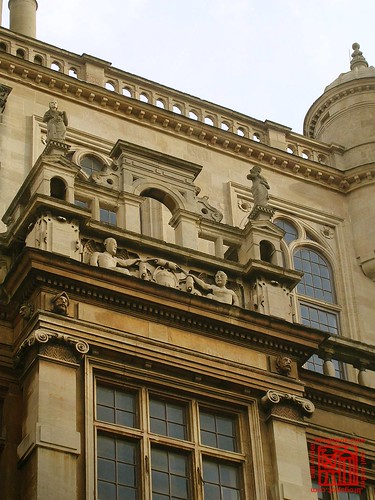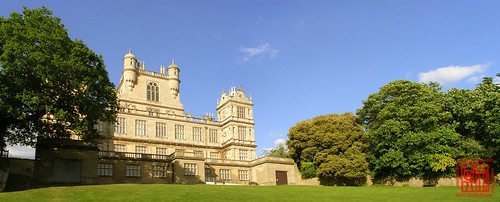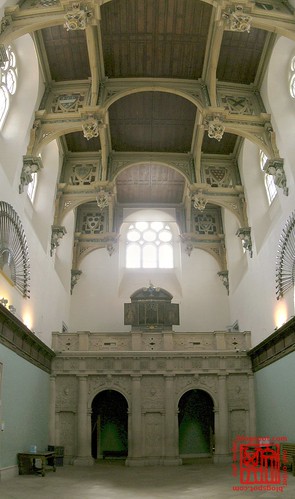Talk to random Malaysians and chances are a majority of them has something to complain about their home countries.
Rather inefficient public transport, controversial entry procedures to public educational institutions, unstable internet connection, incompetent public workers, compromised safety and extremely hot weather are just a handful of the usual public comments.
Some of the issues are so well known that they're actually famous on international levels.
For example, anybody who follows international news know how dramatic Malaysian politics are. I spent nine months in UK and I swear, I've never read papers as boring as theirs. Notable headlines talk about Wayne Rooney's new baby and the story of how a public servant used government money to get a cup of coffee. Even the aftermath of the recently concluded general elections died down quite quickly.
Luckily, I got newspapers for free while I was in England, or I would've wanted my money back.
Online gamers, on the other hand, especially those in Singapore, sympathise Malaysian gamers. One second we were all playing happily, and the next, the Malaysians got disconnected like meat on a butcher's blade. Our weather-affected DSL connection is so notorious that it is often possible to tell weather in Malaysia just by observing Malaysian players. The more often they disconnect, the heavier the rain is.
It's also common sense that most parts of Malaysia are not half as safe as Nottingham, the so called "crime capital of England". Ask around -- every one out of few Malaysians have been crime victims before, including yours truly. It's amazing why haven't anyone taken advantage of the drunkenness of young Englishmen stumbling from pubs before. After all, they're bound to forget the events of the night the next day and just thought they misplaced their purses or wallets.
That, and all the brain drain! The smartest in the country are planning to leave, are leaving, or has left Malaysia to "better places" like Australia and Singapore. Why those places? They don't have newspaper more interesting than your regular Dan Brown thrillers.
But just when you think all hope is gone...
It's 2010 and Malaysia is changing. For one, TMnet has come up with Unifi, a fibre-optic based digital connection. Although this service is still relatively new, it's bound to catch up with and replace the current copper-based weather-vulnerable connection. And it's faster too! The Public Works Department have been rather generous in giving away scholarships to the top scorers of SPM, and that will surely slow down, if not stem, the talent outflow from this country. More policemen have been spotted too, especially around this Raya season.
And the fact that there are people who complain means that there are people who want change and improvement in this country. These are the people who care about the future of Malaysia and these are the people who want to see Malaysia becoming a developed nation one day. With them, who knows, one day, the general Malaysians may have a lot of nice things to say about their country.
So no, Malaysia is not hopeless. It's the entire opposite.
Happy 53rd, Malaysia, and all the best.
Oh wait, except the weather thing. No one can change that.
New to Owl Order? Click here for 2009's best posts! 00:00:00
Tuesday, 31 August 2010
Thursday, 19 August 2010
Sights of Nottingham: Wollaton Hall
Note: High resolution images of all of the following photos are available. Click on the photos to view their higher resolution images.
After seeing the (rather) gloomy indoors of Wollaton Hall, it's time to enjoy the sunshine outside.
Nothing beats a great summer day at Wollaton Park. It's been a very, very long time since I've had that much peace.
There was nothing to worry about, other than the occasional I-have-to-clear-my-bladder problem.

Left: Wollaton Park courtyard and Middle: Wollaton Hall. Probably the only places within Wollaton Park with toilets, unless you don't mind peeing into bushes...
Everything was peaceful and quiet, save for the occasional chirp of birds, rush of wind, brush of leaves and laughter of children.
No skyscraper to block my view, other than the majestic Wollaton Hall. Nothing to stop me from my tracks, except the honey bees and the colourful flowers everywhere.
Everything seemed so free, so lost in time. The only busiest things within sight were typical English clouds, drifting and twisting at unbelievable speeds. I lied down on a park bench and it felt like falling through endless space, clouds neither within reach nor strong enough to support my weight.
Before long, the sun set, it got cold and I became hungry. I started my journey back home, and within 15 minutes, I was standing right beside a busy road, cars hustling past me, driven by busy drivers. I felt like I'd just woken up from a long nap all of a sudden.
A long, long nap with an incredibly sweet dream.
Labels:
Owl's Eyes
Thursday, 12 August 2010
Sights of Nottingham: Museum of Natural History
Note: High resolution images of all of the following photos are available. Click on the photos to view their higher resolution images.
Quite some time ago, I posted pictures of Wollaton Park, split over two posts, here and here.
Right at the heart of Wollaton Park is Wollaton Hall. It was built in the 16th century and is now currently used as Nottingham's Museum of Natural History.
While certainly not as interesting as London's Museum of Natural History (which I visited briefly, photos will be up some time in the future), it's still worth a visit. After all, entrance is totally free, although it is customary to drop a few coins into the donation box.
Wollaton Hall is two-storey tall (or so I remember). Among things you can expect to see in the museum include preserved animals, live insects kept in glass enclosures, stuffed models of birds (some are artificial, some are real preserved animals) and a wide collection of gemstones.

Animal trophies, collected when hunting was still perfectly unregulated and legal.

Close-up of the trophies.

Nope. One year in UK and I haven't seen anyone smoking pipes like this. At least no one non-fictional and alive.

Remember the good ol' radios shown in classic Disney cartoons?

Or the rotate-to-dial phones?
I apologise for the lack of quality of these photos. As usual, it was a big challenge, trying to catch photos in dark interiors with such an old camera. But photos of the Hall's exterior definitely look much better, and I promise they'll be uploaded relatively soon.
Labels:
Owl's Eyes
Saturday, 7 August 2010
Web Gadgets: And Another JavaScript Clock!
One of the first programs I wrote when I learnt JavaScript was a digital clock.
Then, just last month, I wrote an analogue clock, with the hands all made up of periods.
And now, behold! Yet another JavaScript clock. This time, the hands are not made of lousy dots -- they're real hands now, drawn with two of the latest CSS features: transform and transition.
For Google Chrome and Apple Safari users, you should already be able to see hands slowly move between ticks, instead of "teleporting" from location to location. The same goes to Opera users, although some minor bugs may be observed.
Again, for Firefox users, upgrade to version 4.0 or later (4.0 beta currently, at http://www.mozilla.com/en-US/firefox/beta/) to see what you've been missing. Seriously, Version 4.0 is good. Those who prefer to stay with earlier versions will still see a functioning clock with "teleporting" hands though.
Sadly, for Internet Explorer users, this clock doesn't work. You'll have to wait for IE9 to try your luck, sorry about that.
Here goes the source code, for those who are curious. Remember, Blogger.com does NOT support JavaScript at blog bodies, so use a proper HTML/JavaScript gadget for the clock.
Then, just last month, I wrote an analogue clock, with the hands all made up of periods.
And now, behold! Yet another JavaScript clock. This time, the hands are not made of lousy dots -- they're real hands now, drawn with two of the latest CSS features: transform and transition.
For Google Chrome and Apple Safari users, you should already be able to see hands slowly move between ticks, instead of "teleporting" from location to location. The same goes to Opera users, although some minor bugs may be observed.
Again, for Firefox users, upgrade to version 4.0 or later (4.0 beta currently, at http://www.mozilla.com/en-US/firefox/beta/) to see what you've been missing. Seriously, Version 4.0 is good. Those who prefer to stay with earlier versions will still see a functioning clock with "teleporting" hands though.
Sadly, for Internet Explorer users, this clock doesn't work. You'll have to wait for IE9 to try your luck, sorry about that.
Here goes the source code, for those who are curious. Remember, Blogger.com does NOT support JavaScript at blog bodies, so use a proper HTML/JavaScript gadget for the clock.
<style type="text/css">More clocks in the future?
.dot {position:absolute;font-weight:bold;}
#sechand {position:absolute;top:80px;left:40px;width:70px;border:1px dashed;transform: rotate(-90deg) translate(35px,0px);-moz-transform: rotate(-90deg) translate(35px,0px);-webkit-transform: rotate(-90deg) translate(35px,0px);-o-transform: rotate(-90deg) translate(35px,0px);}
#minhand,#hrhand {position:absolute;left:40px;top:80px;width:70px;transform: rotate(-90deg) translate(35px,-1px);-moz-transform: rotate(-90deg) translate(35px,0px);-webkit-transform: rotate(-90deg) translate(35px,-1px);-o-transform: rotate(-90deg) translate(35px,-1px);}
#minhand {border:2px solid;}
</style>
<div style="position:relative;margin-left:auto;margin-right:auto;width:160px;height:170px;" id="labelcontainer">
<hr id="sechand" />
<hr id="minhand" />
<div id="hrhand" /><hr style="width:50px;border:2px solid;position:relative;right:10px;" /></div></div>
<span id="debug"></span>
<script type="text/javascript">
for (var i=0;i!=13;i++)
{
document.getElementById('labelcontainer').innerHTML+="<span class='dot' style='top:"+y_coor(i*5,75,74)+"px;left:"+x_coor(i*5,75,74)+"px;'>."+"</span>"
}
upd_sec();
upd_min();
function upd_sec()
{
var now=new Date();
setTimeout('upd_sec()',1000-now.valueOf()%1000);
var angle=now.getSeconds()*6-90;
if (now.getSeconds()==59)
setTimeout('sec0()',800);
document.getElementById("sechand").setAttribute("style","\
transition-duration:0.75s;\
-moz-transition-duration:0.75s;\
-webkit-transition-duration:0.75s;\
-o-transition-duration:0.75s;\
transform: rotate("+angle+"deg) translate(35px,0px);\
-moz-transform: rotate("+angle+"deg) translate(35px,0px);\
-webkit-transform: rotate("+angle+"deg) translate(35px,0px);\
-o-transform: rotate("+angle+"deg) translate(35px,0px);");
}
function upd_min()
{
var now=new Date();
setTimeout('upd_min()',60000-now.valueOf()%60000);
if (now.getMinutes()==59)
setTimeout('min0()',850);
var angle=now.getMinutes()*6-90;
document.getElementById("minhand").setAttribute("style","\
transition-duration:0.75s;\
-moz-transition-duration:0.75s;\
-webkit-transition-duration:0.75s;\
-o-transition-duration:0.75s;\
transform: rotate("+angle+"deg) translate(35px,-1px);\
-moz-transform: rotate("+angle+"deg) translate(35px,0px);\
-webkit-transform: rotate("+angle+"deg) translate(35px,-1px);\
-o-transform: rotate("+angle+"deg) translate(35px,-1px);");
angle=now.getHours()*30+now.getMinutes()/2-90;
document.getElementById("hrhand").setAttribute("style","\
transform: rotate("+angle+"deg) translate(35px,-1px);\
-moz-transform: rotate("+angle+"deg) translate(35px,0px);\
-webkit-transform: rotate("+angle+"deg) translate(35px,-1px);\
-o-transform: rotate("+angle+"deg) translate(35px,-1px);");
}
function sec0()
{
document.getElementById("sechand").setAttribute("style","\
transition-property: none;\
-moz-transition-property: none;\
-webkit-transition-property: none;\
-o-transition-property: none;\
transform: rotate(-96deg) translate(35px,0px);\
-moz-transform: rotate(-96deg) translate(35px,0px);\
-webkit-transform: rotate(-96deg) translate(35px,0px);\
-o-transform: rotate(-96deg) translate(35px,0px);");
}
function min0()
{
document.getElementById("minhand").setAttribute("style","\
transition-property: none;\
-moz-transition-property: none;\
-webkit-transition-property: none;\
-o-transition-property: none;\
transform: rotate(-96deg) translate(35px,-1px);\
-moz-transform: rotate(-96deg) translate(35px,0px);\
-webkit-transform: rotate(-96deg) translate(35px,-1px);\
-o-transform: rotate(-96deg) translate(35px,-1px);");
}
function x_coor(sec,radius,offset)
{
return (Math.sin(sec*0.10472)*radius+offset);
}
function y_coor(sec,radius,offset)
{
return (offset-Math.cos(sec*0.10472)*radius);
}
</script>
Labels:
Tech
Friday, 6 August 2010
Web Gadgets: CSS3 Transition!
The internet is getting more dynamic than ever.
Twenty years ago, the web was just like an electronic paper. All you could do was to read.
Then, internet got faster -- images started to appear on the web.
10 years ago, we get the ECMAScript, or more commonly recognised as JavaScript. It allowed us to interact with webpages, making modern dynamic sites like Gmail and Meebo possible.
Today, we get CSS3 Transitions.
What does it do? Basically, it allows simple animations with shockingly few lines of codes. For Google Chrome, Apple Safari or Opera users, hover your cursor over any of my links (including the semi-transparent image links below the cbox). You should see the links slowly changing colour instead of snapping instantly, like lightning.
Well, how about Mozilla Firefox and Windows Internet Explorer users? For Firefox users, upgrade to Firefox 4.0 or later to enjoy this feature. Version 4.0 is available as a beta version at http://www.mozilla.com/en-US/firefox/beta/ as of now. It's really worth a try, especially if you're a Windows user.
As for IE users, well, maybe it's time to switch.
See http://hacks.mozilla.org/2010/07/firefox4-beta2/ for another CSS3 Transition sample.
Twenty years ago, the web was just like an electronic paper. All you could do was to read.
Then, internet got faster -- images started to appear on the web.
10 years ago, we get the ECMAScript, or more commonly recognised as JavaScript. It allowed us to interact with webpages, making modern dynamic sites like Gmail and Meebo possible.
Today, we get CSS3 Transitions.
What does it do? Basically, it allows simple animations with shockingly few lines of codes. For Google Chrome, Apple Safari or Opera users, hover your cursor over any of my links (including the semi-transparent image links below the cbox). You should see the links slowly changing colour instead of snapping instantly, like lightning.
Well, how about Mozilla Firefox and Windows Internet Explorer users? For Firefox users, upgrade to Firefox 4.0 or later to enjoy this feature. Version 4.0 is available as a beta version at http://www.mozilla.com/en-US/firefox/beta/ as of now. It's really worth a try, especially if you're a Windows user.
As for IE users, well, maybe it's time to switch.
See http://hacks.mozilla.org/2010/07/firefox4-beta2/ for another CSS3 Transition sample.
Labels:
Tech
Subscribe to:
Posts (Atom)














